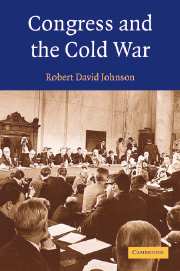Book contents
- Frontmatter
- Contents
- Abbreviations Used in the Text
- Acknowledgments
- Prologue
- Archives Consulted
- Congress and the Cold War
- 1 Constructing a Bipartisan Foreign Policy
- 2 Legislative Power and the Congressional Right
- 3 Redefining Congressional Power
- 4 The Consequences of Vietnam
- 5 The Transformation of Stuart Symington
- 6 The New Internationalists' Congress
- 7 The Triumph of the Armed Services Committee
- Appendix A The Foreign Aid Revolt of 1963
- Appendix B The Senate and U.S. Involvement in Southeast Asia, 1970–1974
- Appendix C The Senate of the New Internationalists, 1973–1976
- Appendix D The House and the End of the Cold War, 1980–1985
- Index
3 - Redefining Congressional Power
Published online by Cambridge University Press: 05 June 2012
- Frontmatter
- Contents
- Abbreviations Used in the Text
- Acknowledgments
- Prologue
- Archives Consulted
- Congress and the Cold War
- 1 Constructing a Bipartisan Foreign Policy
- 2 Legislative Power and the Congressional Right
- 3 Redefining Congressional Power
- 4 The Consequences of Vietnam
- 5 The Transformation of Stuart Symington
- 6 The New Internationalists' Congress
- 7 The Triumph of the Armed Services Committee
- Appendix A The Foreign Aid Revolt of 1963
- Appendix B The Senate and U.S. Involvement in Southeast Asia, 1970–1974
- Appendix C The Senate of the New Internationalists, 1973–1976
- Appendix D The House and the End of the Cold War, 1980–1985
- Index
Summary
Shortly after the 1956 elections, Lyndon Johnson warned Secretary of State Dulles, “We might have some troubles with the Democratic side of the Senate Foreign Relations Committee.” The Majority Leader had learned of Hubert Humphrey's plans to demand a committee investigation of the administration's foreign policy. “If we Democrats,” the Minnesota senator informed colleague Albert Gore, “are not going to think enough of our country – yes, and of our party – to make a careful and intelligent study and investigation of the security needs and foreign policy requirements of this country, then, indeed, we are not performing our public duty.”
Walter George's retirement elevated Theodore Francis Green to the committee chairmanship; the Rhode Island senator, according to Humphrey, threw “cold water” on the plan. Foreign Relations' next ranking Democrat, however, responded more approvingly. In early 1957, J. William Fulbright confessed the obvious: on foreign policy issues, “the Democrats did not function as an opposition party should during the past four years.” Given Green's position, the Arkansas senator recommended terming the initiative a “study” rather than an inquiry: “After such a study is underway, of course, it progresses as developments dictate.” Though the proposed study did not begin until 1958, congressional liaison William Macomber described the story of Eisenhower's second term as the Senate “asserting its role in the foreign policy business.”
Within Congress, the late 1950s witnessed the intensification of a power differential between the House and the Senate, usually at the expense of the House.
- Type
- Chapter
- Information
- Congress and the Cold War , pp. 69 - 104Publisher: Cambridge University PressPrint publication year: 2005



